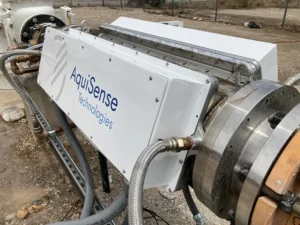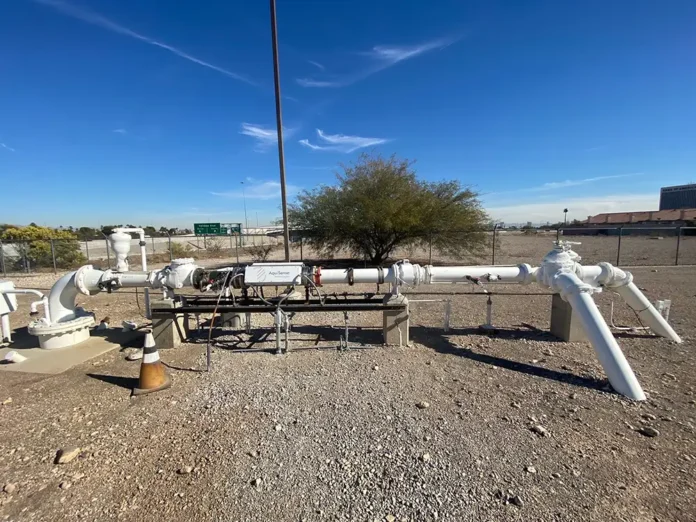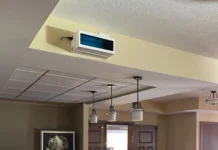By Liz Stevens, writer, UV Solutions
Like communities worldwide, Las Vegas recognizes the value of its water, a resource that is more precious and less plentiful than ever these days. The area even earned its name from the effects of its aquifer and groundwater: In 1829, when Rafael Rivera traveled through this part of Nevada with a Spanish trading party, he saw an oasis in the wild grasses which grew near the area’s natural artesian wells. Rivera called the valley las vegas – Spanish for “the meadows.”
Almost 200 years after Rivera’s visit, the 500-square mile Las Vegas Valley is home to a population of more than 2 million residents. About 90% of its water supply comes from Lake Mead, with the remaining 10% sourced from the local aquifer.
The Las Vegas Valley Water District (LVVWD) is the water service provider for the city of Las Vegas and unincorporated Clark County. The Southern Nevada Water Authority (SNWA), located in Las Vegas, is a regional entity comprised of seven water and wastewater agencies, including the Las Vegas Valley Water District. SNWA is responsible for water treatment and delivery, as well as acquiring and managing long-term water resources for Southern Nevada. The team at SNWA’s Water Quality Research and Development center works to improve the quality of drinking water, including testing and evaluation of new water treatment methods.
SNWA recently conducted a project to evaluate the PearlAqua Tera™, a new UVC LED municipal water treatment system from AquiSense Technologies, Erlanger, Kentucky. UV Solutions spoke with Corey Enus, public outreach for LVVWD, Ariel Atkinson, project manager – applied water quality research at SNWA, and Oliver Lawal, president and CEO of AquiSense, about the project that spurred development of the new PearlAqua Tera treatment system.
The State of Water
Corey Enus set the stage for the project by describing the state of the water situation in the Las Vegas Valley and beyond. “We are in the midst of the longest sustained drought that we have seen along the Colorado River,” said Enus. “Permanent aridification is having a big impact on the amount of water that is being produced and the amount of water that communities are using, and it is going to take water reductions across every single sector across the Colorado River basin for us to continue to hold on as a basin.” Enus stressed that all water users must be a part of the solutions.
The Las Vegas Valley already has instituted comprehensive water re-use measures. “Here in southern Nevada,” Enus explained, “virtually all water that we utilize indoors is recycled, retreated and returned to Lake Mead through the Las Vegas Wash. For every gallon we return to the Colorado River system, we are allowed to withdraw a gallon over and above our 300,000 acre-feet allocation.”
Enus put that recycling paradigm into real-world context: “Here in southern Nevada, you could go to every hotel room on the Vegas Strip, turn on every faucet and flush every toilet; that usage will not impact the amount of water that we are allowed to withdraw as a community from the Colorado River.”
Ariel Atkinson pointed out that her group’s research work is geared toward solving today’s problems but also is undertaken to prepare for tomorrow’s developments. “With lake levels changing,” said Atkinson, “our organization always has planned ahead for water quality changes and changes in water resources – that is a big part of our R&D mission. We look ahead to understand how water quality may change and to plan how we can ensure a continued supply of the highest quality water that we possibly can deliver.”
The Project
That objective – to deliver the highest quality water possible – was the impetus for the project to evaluate AquiSense’s technology. AquiSense, a wholly owned subsidiary of Nikkiso America, designs and manufactures UV-C LED systems for water, air and surface disinfection. The company serves the residential, commercial, healthcare, transportation, life sciences and municipal industries.
“Delivering the highest quality water we possibly can means going above and beyond what is conventional,” Atkinson explained. “One of the things we do in R&D is assess innovative water treatment methods and particularly ones we think could potentially impact our field, as well as our organization. We think UV LED absolutely is the future, and we are early adopters of beneficial groundbreaking technology.”
Enus described how the Water District and the Water Authority connected with Aquisense. “We were interested in UV LED technology but hadn’t found a reliable manufacturer at the scale we needed,” said Enus. “Booky Oren Global Water Technologies knew of our desire and connected LVVWD and AquiSense. We felt confident that AquiSense had the facilities, capabilities and team to meet our needs.”
To provide the technology for the project conducted by this municipality, AquiSense had to scale up from its existing stable of smaller devices. “The PearlAqua Tera was one of the first of what you might consider a full-scale UV LED reactor for municipal use,” said Atkinson. “It was the first product that AquiSense made at that size. And it was the first in the Americas and also one of the first in the world.”
 AquiSense developed the PearlAqua Tera to handle the water volume and the environmental conditions for an outdoor municipal water treatment reactor. “The PearlAqua Tera offers operational benefits specific to LEDs, including a robust design, mercury free operation and low cost of ownership,” said AquiSense’s Oliver Lawal. “This product provides chemical-free disinfection in a small, self-contained unit. The PearlAqua Tera features automatic on/off switching and advanced thermal management. We designed it to offer municipal and industrial level disinfection with flowrates up to 6 MGD (22,712 m3/D).”
AquiSense developed the PearlAqua Tera to handle the water volume and the environmental conditions for an outdoor municipal water treatment reactor. “The PearlAqua Tera offers operational benefits specific to LEDs, including a robust design, mercury free operation and low cost of ownership,” said AquiSense’s Oliver Lawal. “This product provides chemical-free disinfection in a small, self-contained unit. The PearlAqua Tera features automatic on/off switching and advanced thermal management. We designed it to offer municipal and industrial level disinfection with flowrates up to 6 MGD (22,712 m3/D).”
Lawal described the biggest challenges in upscaling AquiSense’s technology for municipal use. “All of our systems at the time were for relatively low flow rates, so figuring out how to scale from 12 gpm to 1,400 gpm was a multi-faceted challenge,” said Lawal. “While the high-level design goals were clear – homogeneous dose distribution, reliable operation, serviceability, etc. – the engineering execution choices were almost infinite.”
Factors affecting the engineering choices included the number of UVC LEDs required to generate sufficient UV intensity to deliver the target UV dose and the photon distribution of those LEDs.
Other issues to address included calculating the expected heat output from an array of LEDs and designing a means of dissipating that heat. “Thankfully,” Lawal said, “given our relatively long track record of in-house UVC LED water treatment system development, we were able to draw on a lot of engineering design and manufacturing expertise already gained.”
This expertise included ray tracing, computational fluid dynamics, thermal simulation, circuit board layout and materials stress analysis. “Due to that advantage, we were able to iterate options quickly,” said Lawal. “Also, the supply chain and in-house Kentucky product-assembly facility that we have for the hundreds of thousands of systems already manufactured and shipped helped us scale quickly and with reduced risk.”
In this project, Atkinson installed the PearlAqua Tera at a groundwater well and compared its performance and operation to a conventional mercury UV reactor. Atkinson was impressed by the PearlAqua Tera. “It did its job,” she said, “and provided disinfecting to the level that we expect. The UV LED reactor worked just as well as a conventional reactor with mercury-based lamps but with the benefit of not having mercury-based technology. That is major benefit.”
Atkinson cited another advantage of this technology, that it works instantly – no lamp warm-up is required – which allows users to turn it off with the confidence that, when switched back on, it will deliver its disinfecting dose immediately. With water demand and UV system usage difficult to anticipate, conventional UV system operators often keep their equipment running continuously, which unnecessarily consumes energy.
“One of the many advantages of LED technology is the ability to instantaneously turn the LEDs on/off with no restriction on the number of cycles per day,” Lawal added. “There is no warmup period needed like there is for conventional mercury-based lamps. This gives the operators a lot more control over their use of the systems.”
Atkinson found the PearlAqua Tera’s ease of maintenance to be an important additional advantage. “It is easier to maintain than a conventional reactor,” Atkinson said. “To maintain a conventional reactor, you have to remove long mercury-based lamps. They are awkward to handle, and they must be handled carefully because of the mercury inside of them. There is an entire handling procedure with safety protocols.” In contrast, to maintain UV LED reactors, an operator simply removes a cover and replaces a part that is like a computer chip. “That is the number one benefit,” said Atkinson. “We don’t have to worry about a mercury lamp breaking and posing a hazard to our employees or, worst case, contaminating the downstream water flow.”
With this project, SNWA went above and beyond the bar for regulatory compliance. “Typically, when a utility purchases a reactor,” Atkinson said, “it is so that the utility can meet a regulation and get a specific disinfection credit by using the reactor. We were not seeking any disinfection credits by using these reactors; we are simply evaluating them in order to provide the highest quality water to our customers.”
Lawal at AquiSense provided more insight into features of the PearlAqua Tera that made it suitable for the SNWA project. “One of the many issues with mercury-lamp based UV systems is the maintenance,” said Lawal. “In starting with a blank slate and the architecture freedom that UVC LEDs afford, we felt that we could significantly improve on product serviceability. Rather than retain a mercury-lamp-type architecture, we designed all replacement parts to be isolated from the reaction chamber while still pressurized.” Operators simply remove a few external fixtures to remove the lamp assembly and reattach a new lamp module.
“Additionally,” Lawal said, “the technology allows for all electronic lamp drivers to be housed in the same assembly, thus negating the need for an additional ballast cabinet and interconnecting cabling. This significantly reduces the system footprint, installation complexity and cost.”
Conventional mercury-based lamps emit light and heat on the same surface. This can often lead to heat induced surface fouling and, in other cases, it can be difficult to keep the lamp at an optimal operating temperature due to process water temperature extremes. “Our UVC LED lamp design,” said Lawal, “is such that the light emitting surface is completely isolated from the thermal emitting surface. This allows us to limit heat induced fouling and maintain stable thermal management under all ambient and process water conditions.”
The Future for Municipal Water Disinfection
“Research never ends,” said Atkinson. “We had good results, and we plan to continue to do research with UV LEDs.” SNWA will continue validating and optimizing the technology by purchasing and installing additional reactors. “We are so happy with the technology,” she said, “that we are expanding our installation of UV LED reactors to five additional groundwater wells with capacities of up to 4,000 GPM in 2023, and we plan to install more each consecutive year.”
AquiSense and LVVWD currently are pursuing funded projects together focused on validation and demonstrating feasibility.
For more information, visit www.snwa.com, www.lvvwd.com and www.aquisense.com.






